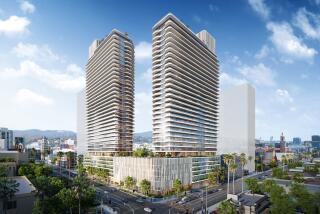Ranking Officer Urges Police Substation at Mann’s Development
- Share via
The commander of the Los Angeles Police Department’s Hollywood Division has proposed establishment of a substation in the new $150-million Melvin Simon & Associates development to discourage crime there.
Capt. Robert Taylor said in an interview that the presence of police officers at the 900,000-square-foot center would act as a deterrent to auto thefts, petty thefts and purse-snatchings.
Ground-breaking on the development, at Hollywood Boulevard and Highland Avenue, is not expected to take place until June. Construction is expected to take 18 months. When completed the project will include a hotel, office tower and retail stores wrapped around Mann’s Chinese Theater.
Included in the project will be 4,200 parking spaces, generating 28,000 average daily trips in and out of the development.
‘Deal With the Problem’
“We do not expect any more crime there than we would in any other large development,” Taylor said. “What we do know is that extra people and extra cars mean more crimes. We would like to be able to deal with the problem at the very beginning, rather than waiting for the problem to develop.”
Taylor said he is drawing on his experience as a resident of Glendale, where the Glendale Galleria shopping complex was opened without Glendale Police presence.
“As you would expect,” Taylor said, “there was a theft problem. Then the city set up a substation in the galleria to cope with the problem. We can anticipate the same problem here.”
Glendale Police said six officers staff the substation at the galleria, which is a 1.3-million-square-foot structure generating up to 60,000 auto trips daily.
Sgt. Steve R. Campbell, a 14-year veteran of the department, said the substation was set up in the galleria in 1981, about five years after the mall was opened, because of a heavy incidence of shoplifting.
“The city made a basic decision that the only effective way to deal with the problem was to set up the substation in the mall itself, rather than having the officers repeatedly going there from the police station,” Campbell said.
“Their sole duty is to patrol the mall, help store owners devise adequate security systems, deal with shoplifting and other crimes and, by their presence, discourage criminal behavior in the mall. We believe their presence in the mall is a very important element in maintaining security there.”
Taylor’s proposal for the project in Hollywood has been endorsed by the Hollywood Heights and Whitley Heights homeowner associations, two groups located in the Hollywood Hills above the new development.
Elliot Johnson, president of the Hollywood Heights group, said residents want to ensure that there is not an increase in crime associated with the new development.
“We support the redevelopment of Hollywood and are in favor of the Melvin Simon project,” Johnson said. “We believe that police controls in the structure itself will be a very strong deterrent to crime.”
Robert A. Higgins, president of the Whitley Heights Assn., said he also supports the development and that a visible police presence in the structure will discourage people who “hang out” on Hollywood Boulevard from loitering in the development.
George J. Mihlsten, legal counsel representing Melvin Simon, said the developer is willing to discuss the proposal even though the developer has “complete confidence” in its own internal security system.
“The Melvin Simon company prides itself on its internal security systems in other redevelopment areas,” Mihlsten said. “At the same time, the commander’s proposal is an interesting one that we will explore with him and the homeowner groups.”
He noted that the retail portion of the development is smaller than the average large shopping center. “There will be 125,000 square feet devoted to retail shops, compared to the 500,000 square feet of your average shopping mall,” Mihlsten said, suggesting that security in the Simon development will be less of a problem than in large malls.
Major elements of the development include a 400-room European-style hotel, an office building, museum and restaurants. The development, which is backed by Los Angeles Councilman Michael Woo, must still be approved by the City Council.
More to Read
Sign up for Essential California
The most important California stories and recommendations in your inbox every morning.
You may occasionally receive promotional content from the Los Angeles Times.










